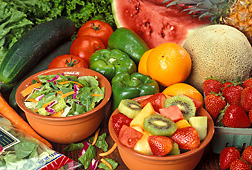Forum—Specialty Crops Move Into the Spotlight
|
|
The strawberries on your breakfast cereal, the leafy greens in your dinner salad, and even the lilac tree you recently planted in your back yard are what growers call “specialty crops.”
These crops—fruits, vegetables, tree nuts, and nursery plants, including ornamental flowers, shrubs, and trees—play a big role in our everyday lives. The food crops add attractive colors, pleasing textures, and distinctive flavors to our meals—along with nutrients and phytochemicals that boost our health. The ornamentals feed our souls with the natural beauty that they bring to our surroundings.
Formerly known as “minor crops,” specialty crops now make up nearly 40 percent of the total sales of all U.S. agricultural products, according to 2004 estimates. They commanded the attention of the U.S. Congress in the form of the Specialty Crops Competitiveness Act of 2004. This legislation is designed to accelerate research, production, and marketing, thus helping U.S. growers capture more domestic and export markets.
To hasten that success, a congressionally mandated Specialty Crop Committee of the National Agricultural Research, Extension, Education, and Economics Advisory Board has pinpointed opportunities and challenges and has offered specific recommendations. The committee’s reports are accessible through the Web at http://nareeeab.ree.usda.gov.
Research organizations such as ARS are using this information to shape studies and set new priorities. ARS has a solid foundation as a world leader in research directed to many specialty crops. Our long history of scientific excellence in this area includes, for example, our grape-breeding program in California’s famed San Joaquin Valley. Research there dates back more than 50 years and has led to some of today’s most popular—and delicious—red, white, and black seedless grapes.
Our iceberg lettuce research is another example. Iceberg is America’s most popular lettuce. Nearly every kind of iceberg lettuce grown in the United States today owes at least some of its parentage to lettuces bred by ARS plant geneticists at Salinas, California, the region known globally as the “Salad Bowl of the World” for the premium salad vegetables grown there.
In addition, we have more than 75 years of achievements in floriculture research at the ARS-managed U.S. National Arboretum in Washington, D.C. Attractive, hardy plants from that research—elms, dwarf viburnums, and more—today flourish in parks and home gardens.
This issue of Agricultural Research highlights other specialty crops research that is already in progress. All the studies help make production of these plants economically and environmentally sustainable.
Our overview of what’s known as the “IR-4 program” gives you a glimpse into nationwide research on pesticides for specialty crops. Some of these crops are small in acreage but high in value, such as coriander and other herbs or azaleas and other flowers. IR-4 provides the information necessary to obtain regulatory approval for chemicals suitable for use on these or other plants.
You can read about work that’s helping protect beans, sunflowers, and other plants from one of their worst fungal pathogens, Sclerotinia. This microbe causes a serious disease known as “white mold.”
Check out the spinach studies that ARS scientists in California are conducting. This research has yielded new parent plants that boast unique resistance to a notorious insect pest, the leafminer. And tests at our nutrition centers in Texas and Massachusetts have revealed new estimates of how much of the beta-carotene in spinach our bodies can actually convert into vitamin A, an essential nutrient.
See how experiments in Florida and Thailand are documenting the nutritional compounds in luscious tropical crops like guava and passion fruit or how our scientists in West Virginia have created a plum variety that resists the devastating plum pox virus.
There’s more. Our experts at the U.S. National Arboretum are breeding beautiful new street trees tough enough for city living. Enjoy the account of our specialty crop genebanks, and see why our future depends on safeguarding these plants’ wild, exotic, and wonderful relatives.
These articles present just a few examples of ARS research. Our science spans the globe and covers nearly every aspect of producing specialty crops.
ARS investigations are outlined in carefully designed 5-year plans. But our planning horizon extends farther into the future. And it has the built-in flexibility to take into account changes in global climate, population growth, nutritional needs, and other factors.
Today, thanks in part to ARS research and that of collaborators here and abroad, Americans have ready access to exciting, abundant, and affordable specialty crops at supermarkets and at plant nurseries. With continued planning, foresight, and dedication, we can create an even more bountiful array of these crops for the health and enjoyment of future generations.
Sally M. Schneider
National Program Leader
Horticulture Pathogens and Germplasm
Beltsville, Maryland
Gail C. Wisler
National Program Leader
Horticulture and Sugar Crops
Beltsville, Maryland
"Forum" was published in the October 2007 issue of Agricultural Research magazine.







